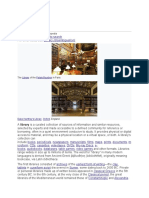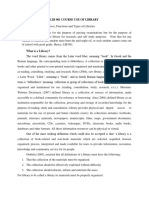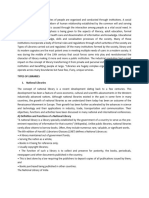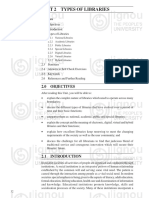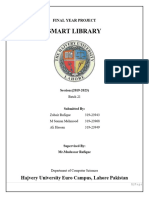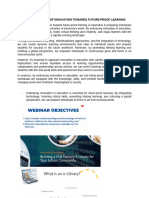YABA COLLEGE OF TECHNOLOGY
(SCHOOL OF LIBRARY STUDIES)
DEPARTMENT OF LIBRARY AND INFORMATION SCIENCE
COURSE CODE:
LIS 111
COURSE TITLE:
FOUNDATION OF LIBRARY AND
INFORMATION SCIENCE
LECTURER: MRS OGUNLEYE
(Group D)
TITLE : TYPES OF LIBRARY
1
� PRESENTERS
NAMES MATRIC NUMBER
KEHINDE OREOLUWA NOT YET
JOSHUA SERAH F/ND/24/3920001
EMEREONYE VICTORY F/ND/24/3920012
SAMUEL VICTOR F/ND/24/3920033
OGECHI DURU F/ND/24/3920034
OLAGOKE SAMUEL F/ND/24/3920038
EGBERONGBE NIMOTA NOT YET
BUSARI MICHAEL NOT YET
FATHIAT LIMAN NOT YET
TOBILOBA TEMITOPE NOT YET
2
� INTRODUCTION
A Library can be defined as a repository
house (store house)where books and other
media through which other information is
transmitted either in electronic or physical
format passing through processing and
organization of professionals with the
ultimate intention of making them accessible
for easy and timely use by patrons.
A library is also a place where people can
read, borrow and study books or other
learning materials.
There are different types of libraries and
each one serves a different purpose or group
of people.
3
�The types of libraries
are listed below:
1. ACADEMIC LIBRARY
2. PUBLIC LIBRARY
3. PRIVATE LIBRARY
4. SPECIAL LIBRARY
5. VIRTUAL LIBRARY
6. SCHOOL LIBRARY
7. NATIONAL LIBRARY
4
� ACADEMIC LIBRARY
This is a library that is established and
maintained by an academic
institution(such as a university, college)
to support its curriculum, faculty, and
student body by providing access to
scholarly resources, research tools, and
learning services.
COLLECTIONS
1. Printed materials: Textbooks,
scholarly books, journals.
2. Digital resources: E-books, academic
databases (e.g., JSTOR, PubMed,
Proquest), they also provide videos,
audio files, interactive learning tools.
5
� PUBLIC LIBRARY
This is a publicly funded library that
provides free access to books, media,
internet, educational programs, and
other resources and services to all
members of a community, regardless of
age, background, or income.
COLLECTIONS
1. Printed materials: BOOKS
(fiction, non-fiction, biographies,
children’s literature).
2. Magazines & newspapers
3. E-books and audiobooks (via
platforms like libby, Overdrive).
4. Local history & archives.
6
� PRIVATE LIBRARY
This is a library with collections of
books, manuscripts, or digital resources
owned and maintained by a private
individual, family, organization, or
institution. Access is limited to
authorized users, and the library’s
primary purpose varies depending on the
owner’s goals, personal enrichment,
research, preservation, or organizational
needs.
Types of private libraries
1. Personal libraries: This are owned
by individuals or families, they
often reflect personal interests
(e.g., religion, art, rare books),
7
� they can be large or small (e.g.,
home libraries, rare book rooms)
2. Organizational libraries: This
belong to private companies,
NGOs, religious institutions,
political parties, or law firm, They
serve internal users (e.g.,
employees, researchers, clergy)
collections are focused on legal
texts, theological archives,
business reports.
3. Private research libraries: They
serve specialized research
communities (e.g., think tanks,
8
� private).Access may be granted by
request or membership.
SPECIAL LIBRARY
A special library is a library that focuses
on a specific subject area, discipline, or
type of user—unlike public or academic
libraries that serve broader audiences.
These libraries are usually part of a
company, government agency, museum,
hospital, law firm, or other specialized
institutions and are designed to support
the specific information needs of that
organization.
Examples of special libraries are
9
�LAW LIBRARY, MEDICAL
LIBRARY, CORPORATE
LIBRARY, GOVERNMENT
LIBRARY, MUSEUM LIBRARY,
NGO/ADVOCACY LIBRARY,
MILITARY LIBRARY E.T.C.
VIRTUAL LIBRARY
A virtual library(also called a digital
library)is a platform that provides 24/7
remote, internet-based access to
organized collections of electronic
resources and library services,
supporting users in research, education,
and life long learning.
Features of a virtual library include:
10
�1. ONLINE ACCESS: This provides
users access via computer, phone,
or tablet from any location.
2. DIGITAL RESOURCES: Users
have access to E-books, e-journals,
articles, theses, videos and data
bases.
3. SEARCH TOOLS: Key word
search, filters, full-text access.
4. USER AUTHENTICATION: Users
are enabled to login through
username/password or institutional
ID.
5. VIRTUAL SERVICES: Users are
able to consult online reference
help, chat with librarians for
document acquisition.
11
�Examples of virtual libraries are
Project Gutenberg, Internet Archive,
World Digital Library(WDL),
HathiTrust Digital Library, National
Digital Library of INDIA.
SCHOOL LIBRARY
A school library is a learning resource
center located within a school(primary
or secondary) that provides students,
teachers, and staff with access to books,
educational materials, technology, and
support services to enhance learning,
reading, and academic achievement.
Features of a school library include:
12
�1. Balanced collections: This appeals
to diverse reading levels and
interests.
2. Technology access: Availability of
computers, tablets, internet for
research and learning.
3. Student-centered design:
Comfortable seating, accessible
shelving, and child-friendly layout.
4. Flexible scheduling: Open before
or after class; integrates with school
timetable.
5. Inclusive environment: It is safe
and welcoming for all genders,
cultures, and learning needs.
13
� NATIONAL LIBRARY
A national library is the official library
of a country, established and funded by
the government to collect, preserve, and
provide access to the nation’s published
and recorded heritage. Unlike the other
types of libraries, national libraries
typically do not lend materials. A
national library serves as a repository of
information, safeguarding cultural,
historical, legal, and scholarly output of
the country and often functioning as the
bibliographic center of the nation.
KEY FEATURES OF A NATIONAL
LIBRARY
14
� 1. LEGAL DEPOSIT LAW: It
requires publishers to submit copies
of all published works.
2. NATIONAL COLLECTIO N: It
includes books, newspapers, maps,
sound recordings, and digital files.
3. DIGITIZATION PROJECTS:
Large-scale access to national
archives and cultural heritage.
4. PRESERVATION LABS:
Conserves fragile documents,
manuscripts, and historical media.
5. ARCHIVAL ROLE: Maintains
government documents, rare
collections, and literary works.
Examples of national libraries are
15
�National library of Nigeria(ABUJA), British
library (LONDON), Library of congress
(Washington, D.C.)E.T.C.
In conclusion all libraries irrespective
of their types or functions serve the
same purpose to provide users with
quality information.
REFERENCES
Wikipedia contributors. (2025).
Library.Retrieved from
https://en.wikipedia.org/wiki/library
ScienceDirect. (2025). Library and information
science. Retrieved from
https://www.sciencedirect.com/topics/social-
science/library-and-information-science
16
�American Library Association.(2025). Types of
libraries. Retrieved from
https://www.ala.org/educationcareers/careers/li
brarycareerssite/typesoflibraries
International Federation of Library
Associations and Institutions (IFLA). (2025).
Types of libraries. Retrieved from
https://www.ifla.org/units/libraries-for-
children-and-young-adults/
17














